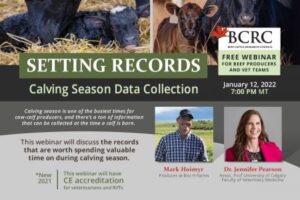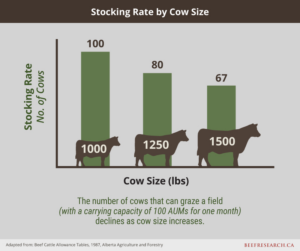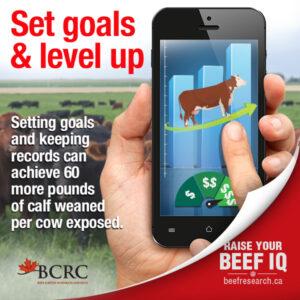A Guide to Keeping Records that Help Make Profitable Decisions
Do you feel like you have a good understanding of your farm’s profit and production? Do you have goals for the upcoming season?
You can learn a lot about your farm when you make the effort to collect and take a look at your financial and production data. Perhaps you assumed an area of your operation was performing better than it truly was and records demonstrate improvement is needed. On the other hand, analyzing data may point to improvements that you didn’t realize occurred.
Good farm records are useful to provide the data needed to understand your farm performance and will help take the guesswork out of management decisions. Research shows that when producers set goals and keep records, they can achieve up to 60 more pounds of calf weaned per cow exposed. Benchmarking also helps producers be prepared for challenging times such as drought and other environmental disasters, and will maximize the benefits of your annual VCPR (Veterinary Client Patient Relationship) visit with your herd veterinarian.
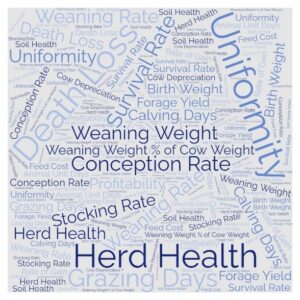
In the Canadian Cow-Calf Cost of Production Network, there were 115 producers across Canada that shared what productivity measures they monitor on a regular basis. At the top of the list were:
- conception rate,
- calf survival rate,
- weaning rate,
- weaning weight,
- calf uniformity,
- calving days,
- overall herd health,
- grazing days on pasture and extended grazing,
- forage yield,
- stocking rate and
- profitability.
When asked “What management practice changes or tools are you considering?” many producer participants answered that they were committed to better record keeping.
What management practice changes or tools are you considering?
— Canadian Cow-Calf Cost of Production Network Participants, 2021 |
Getting Started:
The Cow-Calf Production Indicators Calculator is a tool on BeefResearch.ca to help you identify key animal performance indicators and compare them with industry targets and regional benchmarks from recent regional cow-calf surveys. Most of the information can be found from a calving book or paper records, such as preg-checking results.
Only 15 numbers are needed to calculate performance indicators including:
- cow-to-bull ratio,
- length of calving period,
- conception rate,
- calving distribution,
- pregnancy loss,
- calving rate,
- calf death loss,
- calf survival rate,
- weaning rate,
- pounds weaned per female exposed and
- weaning weight % of cow weight.
(Learn how to measure and use these indicators here.)
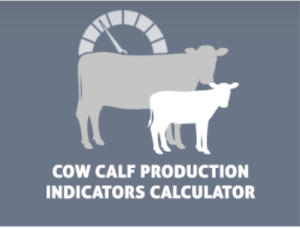
When you use the Cow-Calf Production Indicators Calculator, you will see a snapshot of your farm for that particular year, and how it measures up to long-term industry targets and regional benchmarks. This can help you determine where improvements may be made on your operation from breeding through weaning. If you use the calculator year-after-year, you can identify your own benchmarks to compare to improve upon over time.
For example, you may use the calculator to compare your calving distribution numbers over the past few calving seasons and note that your calving interval has become stretched out. More cows are calving in the second and third cycle than you would like, resulting in a less uniform calf crop at weaning. You may choose to address this by implementing practices such as reducing the breeding season length, or choosing to market cows bred after a certain cut-off date. Over time, having more calves born earlier in the season may help to increase weaning weights however your conception rate may decrease while you apply this change.
In addition to production indicators, the BCRC also has a suite of record-keeping resources for animal health and performance, forage and grasslands, genetics and financial data. These topics are covered in the record-keeping modules that are designed to be used by a wide range of producers and management systems, targeting different levels of experience:
- Level 1 is a good starting point for beginners, and contains many of the parameters of the Cow-Calf Production Indicators Calculator;
- Level 2 is for someone that has started some records but would like to expand their data collection; and
- Level 3 builds upon the first two levels to dig deeper into analysis and application.
An example from Level 2 looks at mature cow weight and the industry target of a cow weaning a calf that is 45% of her body weight.
Producers need to know their weaning weights and cow weights, which can typically be found from sale tickets. For example, if the average cow weight on a farm is 1250lb and the average weaning weight for calves is 578lb, that herd is weaning calves that are 46.2% of the cows’ body weight, which is above the target.
Producers could take this information to Level 3 to look at how cow size impacts forage demand and carrying capacity of pastures. For example, a 100-head cow herd that weighs an average of 1000lb will eat less (i.e., demand less forage) than a 100-cow herd that weighs 1250lb. Both herds would demand less forage than a 100-head cow herd comprised of 1500lb cows.
There are a lot of different options for keeping records, ranging from paper records, such as calving books, to computerized records like Excel or Google Sheets, or herd management software programs. Some management programs are free, while others require a subscription fee.
Computerized formats may allow for quicker analysis or for multiple users to access information, however the type of system producers implement will vary by personal preference.
Collecting, maintaining and analyzing records takes a commitment, but the payoffs are worth it. Research shows that record-keeping and setting goals increases weaning weights which translates to greater profit. There is also benefit to building a greater awareness of how your farm operates. Extra time and in some cases additional equipment and tools, such as a weigh scale or herd software, may be needed however this infrastructure may be a worthwhile investment toward increased efficiency and profitability.
There is a familiar saying “the best time to start was yesterday, and the next best time is now.” Think about how the changes you make right now, including the time you invest in collecting and understanding your farm data, can impact your production and profits in the coming years.
Learn More:
- Setting Records: Calving Season Data Collection Webinar (BCRC Webinar)
- Introduction to Record Keeping and Benchmarking (BCRC Resource Page)
- Record Keeping and Management on Western Canadian Farms and Ranches (BCRC Research Fact Sheet)
- Making Farms Decisions Easier (BCRC Blog Post)
